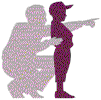Avoiding common mistakes
- Behavior can be modified by praise/reward as well as reproof/punishment. It is best to use a combination of both, and give several times more praise for good behavior as reproof for bad behavior. Children who get too little attention when they are well-behaved often try to get more attention by misbehaving. So remember to reward good behavior with lots of attention.
- Clearly communicate expectations, boundaries, and consequences. Children depend on consistent direction. Boundaries and consequences need to be clear. If they cross those boundaries accidentally or in childish irresponsibility, pull them back in. But if it is through willful disobedience, then there should be consequences.
- Read Tips for Gentle Discipline by SaferChild, Inc. It contains very valuable advice on gentle and effective discipline methods, especially for younger children. Also, read Preventing Abuse of a Child for tips on preventing physical abuse in your home.
- Before considering a spanking, remind yourself of the many alternatives. A warning, a lecture or a scolding may suffice, for example. If you think a punishment is required, consider the use of logical consequences, time-outs etc. instead of a spanking. Including spankings in your parental toolbox does not mean this is your only tool.

- Spanking should be used sparingly and only for "major offenses", e.g. an action that can cause injury to the child or others, or an action that will get them in trouble with the authorities when they are older. When spanking is overused it will soon become ineffective or even counterproductive. In addition, reliance on spanking as a discipline approach makes other discipline strategies less effective to use. When spanking is used as a primary method of discipline, time-outs and positive reinforcement are more difficult to implement and take longer to become effective.
- According to studies and common experience, spanking is most effective in the age of approximately 3-9 years. Above that age, spanking becomes less and less effective. This website does not encourage spanking above the age of puberty. You can find good recommendations for teen parenting and non-corporal disciplining methods in any modern parenting book and on anti-spanking websites (see References and Links).
- No two children are alike. Some may respond well to spankings, others may respond better to other discipline methods. Some children may experience even mild spankings as traumatic (refer to the letter of 28-Nov-2000, Reader's feedback). A loving parent should respond to the child's peculiarities and fashion punishments accordingly. There are plenty of alternatives to spanking. (If you have several children, they may find this approach unfair, and in some way they are right. Still, try to make them understand the reasons.)
- Make clear "house rules", and give no punishment if none of these rules were broken. It is not fair to punish a child for something he/she did not know was wrong. Remind your child of the rules if he/she seems to have forgotten them. Before punishing, if possible, give at least one more warning (e.g. "If you don't (...) now, you will get a spanking"). Children tend to forget rules quickly, so giving a last chance is fair.

(Have this sign on your wall, figuratively speaking)
- If you threaten to give a certain punishment, you must follow through. So think twice about whether you will really do it before threatening a spanking. If you make empty threats, your child will recognize them quickly, and the result will be worse behavior.
- If you are angry, you are not as controlled as when you are not. You are likely to spank harder than necessary and fail to adequately explain to your child why he/she is being punished. Your child is likely to feel like an innocent victim of your anger. It will most likely believe you are overreacting to a minor offense.
- That is why you will - rightly - feel miserable after a having given spanking in anger. Spanking without anger is the most important, but also the most difficult part of "spanking with love". Disciplining calmly stresses the fact that the spanking is not an overreaction, but an appropriate and necessary consequence.
- There are two main strategies to avoid punishing in anger. The first is to punish misbehavior before one gets really angry. This means to establish a relatively strict regime - to expect obedience at the first word and punish disobedience as soon as it shows, calmly, before any real anger can build up. The second strategy is less strict, and useful when the parent is already angry. In that case, it is essential to wait until the anger has vanished before dealing with the punishment, if any. Giving yourself a time-out of a few minutes usually helps best. During that cooling-off time, it is recommendable to send the child to his/her room.
- Like any punishment, a spanking should be administered as quickly after the offence as possible. However, do not rush into the spanking. React quickly to the offense, but if you decide to give a spanking, take a deep breath and take your time to do it unhurriedly. Your child is likely to be nervous and excited. Your task is to set a good example of parental self-control and calmness. Talk quietly with your child about what had happened and why the punishment is necessary. Then take as much time as you want with the preparations for the spanking. Haste is a sign of lacking self-control and not of disciplining with love.
- A spanking is not mainly about the infliction of pain. The "ceremonial aspect" of the procedure is much more important. Therefore, a parent should be highly concerned to make the spanking "ritual" feel right. It stresses the civil and controlled - not barbaric! - nature of the punishment.
- Go to a private place where you will be undisturbed. As a rule, parents should always praise/reward in public, but reprove/punish in privacy. A spanking in the presence of others (even if they are members of the family) is humiliating and unfair to the child.

- Some parents punish immediately and tell the child afterwards what he/she did wrong. Don't do this. Before the spanking, sit down and talk with your child about what happened. Don't yell. Speak normally. This will make sure that your child knows what he/she is punished for, and puts the focus of thought to the offense committed. Tell your child that you love him/her very much, and that the disciplinary consequence is necessarry because of this love, not despite.
- Even if your child refuses to listen to you, do not yell or shout. In such a case, crouch down to his level, grasp his/her arms firmly so he/she cannot avoid looking at you, and then talk calmly.
- When you are sure your child understands the wrongness of the offence and the necessity of punishment, adopt your choice of a spanking position (preferrably "over the lap", see chapter Spanking positions).
- "Never slap a child in the face when nature has provided a better place." Only the child's bottom is well-padded enough to endure a spanking without injury.
- Spank only with your flat open hand. This avoids the danger of injury and is painful enough, even for older children. (See chapter Spanking implements).
- For more recommendations, read the chapter Spanking techniques.
- To be effectual, the spanking must be neither too severe nor too mild. You should choose the severity with great care on a case-by-case basis, considering all factors like
- the offense
- the child's age
- the child's personality
- the situation when the offense was committed
- other factors (e.g. repeated or first-time offense)
- Any spanking should be immediately followed by love and affection. Show your child that he/she has been forgiven, "the debt is paid" and that you are not angry anymore. Hugging is very recommendable as a sign of reconciliation.
- If spanking does not seem to work, a parent should never increase the severity of hitting. Professional help should be sought, and/or other disciplinary techniques tried.
Last update: May-14-2003
